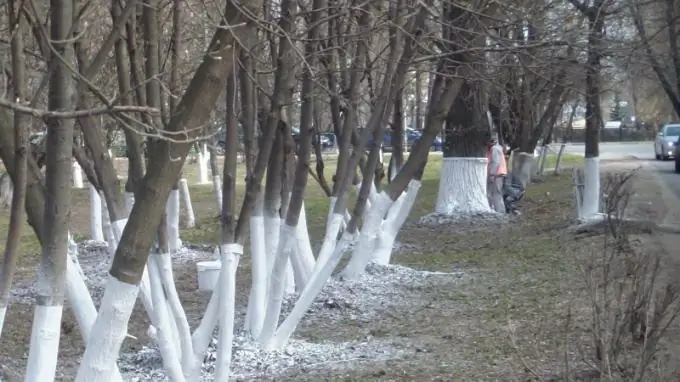- Author Nora Macey [email protected].
- Public 2023-12-16 10:17.
- Last modified 2025-01-23 08:47.
Light tree trunks are common in the spring. People whiten them for a reason. Perhaps for many, this is really just a tradition, but quite useful. The correct whitewashing can protect the tree from many unwanted influences.

Instructions
Step 1
Many people whitewash trees for beauty. White trunks give the alleys and gardens a solemn look. That is why whitewashing is usually carried out for the May holidays. The elegant look of trees is sometimes complemented by various colored stripes and patterns. Probably, it's all about the human perception of the world. Since everyone is accustomed to seeing light tree trunks in the spring, then they need to be whitewashed.
Step 2
Often, gardeners cover the trunks and lower parts of tree branches with whitewash for a completely different reason, not related to beauty. The fact is that whitewashing helps prevent overgrowth of mosses and lichens. Some consider this event useless, because if a lichen settles on the trunk of a garden tree, this indicates a favorable ecological situation on the site. On the other hand, various insects can hide in mosses and lichens that can harm the garden. In addition, mosses and lichens usually grow on damaged areas of the trunk. This can prevent the grower from detecting a wood wound in time and thus lead to a deterioration in the condition of the tree. That is why people often clean off mosses and lichens from the trunks, if necessary, cover the damaged areas with garden pitch, and then whitewash the trees.
Step 3
Another reason for whitewashing garden trees is to protect against pests. The fact is that insects like to settle in cracks in the bark. With the help of whitewashing, these small defects in the trunk are closed. In addition, if you regularly inspect your trees, then you will probably appreciate other advantages of whitewashing - pests are very clearly visible against a light background, which means that you can get rid of them in a timely manner.
Step 4
It is possible to note another rather significant reason for the whitewashing of tree trunks. White color is able to protect the tree from overheating by reflecting part of the sun's rays. The fact is that if the crown of fruit trees is not yet spreading enough, or simply did not have time to grow foliage after winter dormancy, then the sun can dry out the trunks and even leave burns. From this, tiny cracks appear, they may not be visible to the naked eye, but are extremely dangerous for the health of fruit trees, because through them the plant begins to lose precious moisture.






